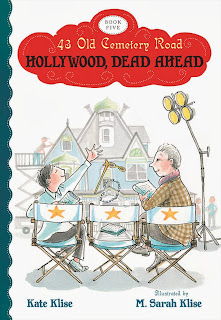Klise, K. (2013). 43 Old Cemetery Road: Hollywood dead ahead. New York, NY: Houghton Mifflin Harcourt.
Is stardom in the cards?
Summary:
The 43 Old Cemetery Road gang is back again and clever as ever. This time their collective talents have landed them an offer for a movie deal for their books. But, the path to fame is never easy as the family of three soon realizes. Iggy and Seymour get caught up in their own transformations from ordinary to slick Hollywood extraordinary, while Olive is left out in the cold. Will she be able to save her family in time from being swindled? Will their story ever make it to the big screen? Will a clause in their contract become deadly?Impressions:
I am continually impressed with this series. Each installation is zanier and more detailed than the last as Klise's audience grows up. I felt like this edition was more complex and the wordplay more intriguing. I love the family bond between Olive, Iggy and Seymour, and I see the potential for several more installations as the family itself continues to grow. Lots of humor and heart, and cleverness dispersed throughout. Postcards, newspaper clippings, and pictures round out the "Hollywood" experience.
Reviews:
From Kirkus Reviews:
This fifth hilarious excursion to Seymour Hope's address in Ghastly, Ill., takes the little, idiosyncratic family to Hollywood when an unscrupulous movie mogul decides to film their stories. Young Seymour and ghost Olive can't wait to become movie stars, while crotchety Ignatius remains cautious. Pushed into it by majority rule, Ignatius signs the lengthy contract, only to learn later that he has signed away all rights to the trio's books, past and future, for no compensation whatsoever. When they arrive in Hollywood, everything goes wrong. Ignatius becomes consumed with his image makeover, especially his new teeth. Seymour auditions to play himself in the movie and wins the part, but Olive fumes because the movie company ignores her (she is invisible, after all). They find an ally in Ivana Oscar, the 92-year-old former star tapped to play Olive when Ivana learns that her contract demands her death in order to boost profits for the film. As always, the comedy depends on deliberately awful puns, especially in the characters' names, such as Moe Block Busters, Hugh Briss and Phillip D. Rubbish. M. Sarah Klise's exuberant drawings contribute half of the book's content. Kate Klise delivers the text in the form of letters, memos and newspaper articles, with humor stuffed into every corner. Another winner for this inventive series. (Humor. 8-12)
From Horn Book Magazine:
In their fifth book, young Seymour and his collaborators/caretakers Grumply (alive) and Olive (a ghost) land a movie deal for their bestselling on-going serial ghost story, 43 Old Cemetery Road. But Tinseltown isn't all glitter--producer Moe Block Busters changes the script, and fame changes the writers. This mild mock-gothic tale is told through playful narrative devices: letters, newspaper extracts, and black-and-white illustrations.
Citation: Hedeen, K. (2013, October 7). From the guide: Slightly spooky middle-grade tales. The Horn Book. Retrieved October 26, 2013, from http://www.hbook.com/2013/10/choosing-books/from-the-guide-slightly-spooky-middle-grade-tales/#_
Library Activity:
One of the qualities that makes Klise's 43 Old Cemetery Road series unique is the writing. She intermixes newspaper articles, letters, postcards, and illustrations to tell her tales. Begin by sharing one of her books, such as her most recent work, Hollywood, Dead Ahead. Either read pieces of it aloud and provide some background on the series. Invite kids to participate by assigning characters to students. You might even want to use a document camera to project the book pages since much of the interpretation relies on visuals. As a follow-up activity, discuss the importance of written communication by sharing blogs written by popular children's authors. Many authors, including the Klise sisters, offer writing advice, book recommendations, and personal insights on their blogs. Link the authors's blogs to library Web site. In addition, share user-friendly blogging sites with students so that they too may start a blog.
The Klise sisters's blog: http://www.kateandsarahklise.com/our-blog.html
The Klise sisters's blog: http://www.kateandsarahklise.com/our-blog.html






